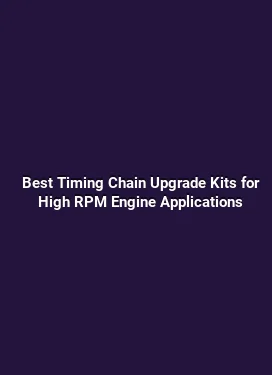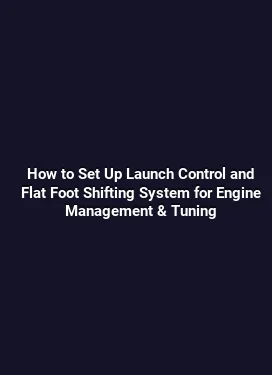How to Tune Cam Timing with Variable Valve Timing System
Fundamentals of Variable Valve Timing and Its Impact on Cam Timing

Variable valve timing (VVT) systems revolutionize how an engine breathes by adjusting the relative timing between the camshaft and the crankshaft during operation. This dynamic adjustment modifies valve lift and duration, which in turn influences peak torque, broadens the usable RPM range, and can improve throttle response. A solid tuning approach begins with understanding how the VVT actuator, solenoids, and the hydraulic control manifold respond to electrical signals from the engine management system. Key variables to observe include oil pressure, actuator travel, cam phasing angle, and the interaction of VVT with the intake and exhaust timing maps. By mapping these relationships, a tuner can craft a timing strategy that respects mechanical limits while extracting meaningful performance gains across the RPM spectrum.
In practice, VVT does not operate in isolation. It interacts with intake runner length, turbocharger or supercharger pressure, exhaust backpressure, and even spark timing. The goal is to harmonize cam phasing with fuel delivery and ignition so that the engine maintains stable idle, reduces knock tendency, and achieves efficient combustion under various loads. Real-world tuning requires a combination of data logging, controlled experiments, and gradually progressive changes to avoid introducing drivability issues or mechanical stress.
Tools, Data, and Baseline Measurements for Safe Tuning
Before making any changes, establish a solid baseline. This includes recording whether the engine uses a hydraulic or electric VVT actuator, the oil pressure under different operating conditions, and the stock cam phasing limits. A high-quality data logger should capture live cam phasing angle, boost or manifold pressure, RPM, load, knock sensor activity, air-fuel ratio, ignition timing, and throttle position. Baseline traces help identify how the system responds to load changes and RPM ramps. With a reliable baseline, tuning can proceed in a controlled, repeatable manner rather than relying on guesswork.
When evaluating cam timing, pay attention to the relationship between phasing and engine speed. In many engines, the cam phaser will advance timing at mid to high RPM to optimize cylinder filling and expansion. Conversely, timing retards at low RPM can improve idle stability and reduce roughness. Document the stock phasing range and the corresponding horsepower and torque curves as reference points for future adjustments. This provides clear targets and prevents over-tuning that could lead to mechanical interference or valve float at high RPMs.
Strategic Approaches to Intake vs. Exhaust Cam Timing
Changing the intake cam timing typically affects low- to mid-range torque and throttle response, while adjusting the exhaust cam timing can influence peak power and drag on the intake charge. A common starting point is to slightly advance the intake phasing to improve low-end response, then test exhaust phasing to see if peak power can be broadened without sacrificing transmission of knock-sensitive regions. For engines with dual VVT (both camshafts adjustable), a coordinated approach is essential: advancing one cam while retarding the other can unlock a broader torque curve without increasing intake manifold pressure excessively.
During testing, isolate one variable at a time. For example, hold exhaust phasing constant and incrementally adjust intake phasing in small steps (for instance, 2–3 degrees at a time) while monitoring idle stability, RPM response, and A/F behavior. After each step, perform a controlled dyno run or track a road section with a defined load profile to capture repeatable data. If the engine begins to exhibit rough idle, misfire symptoms, or increased knock sensor activity, re-evaluate the adjustment range and consider revisiting fuel or ignition maps to maintain safe combustion conditions.
Practical guidelines for phasing limits and safety margins

Most VVT systems have mechanical and electrohydraulic limits that prevent the phaser from moving beyond safe boundaries. When tuning, stay within manufacturer-recommended ranges and avoid aggressive phasing changes at very high RPM if oil pressure or actuator reliability is uncertain. Always verify that the mechanical clearances and valve train components are in good condition before pushing the envelope. A cautious, data-backed approach reduces the risk of valve-to-piston contact or valve stem wear that could result from excessive phasing at high engine speeds.
In-Depth Tuning Scenarios: Naturally Aspirated vs Forced Induction
In naturally aspirated (NA) engines, cam timing adjustments can yield noticeable gains in mid-range torque and throttle response without compromising top-end power. The tuning strategy focuses on optimizing the balance between intake and exhaust phasing to preserve a smooth idle while widening the usable RPM window. For turbocharged or supercharged engines, the goal shifts toward compensating for increased cylinder pressure and potential knock tendency. In these cases, phasing adjustments should be made alongside fuel and ignition maps to manage dynamic compression and heat soak during boost transitions.
When dealing with forced induction, the available dynamic range for cam timing adjustments often expands because the system can leverage pressure differentials created by the charger. However, care must be taken to avoid excessive intake manifold pressure at low RPMs, which can impede fuel atomization and degrade combustion stability. A methodical approach involves incremental phasing changes during steady-state boost holds, paired with short, controlled pulls on the dyno to capture the resulting torque and power shifts. Document all observations, including the interplay with boost regulation and throttle response, to build a robust tuning profile that remains reliable under street and track conditions.
Dynamic Tuning on the Dyno and Real-World Validation
Dyno testing remains the most reliable pathway to quantify the impact of cam timing changes. Begin with a warm-up cycle and establish a safe baseline pull with stock phasing. Introduce a small phasing adjustment and record steady-state power and torque across the RPM range, along with injector duty cycle, A/F ratio, LUT (lookup table) adjustments, and ignition timing. A useful practice is to perform a handful of equivalent pulls with each adjustment to average out transient effects and ensure repeatability. The data gathered should reveal whether the changes translate into meaningful gains across targeted rpm bands or if gains plateau and other tuning levers become more effective.
Road validation complements dyno results. Simulate typical driving scenarios: part-throttle accelerations, sustained highway cruising, and abrupt throttle inputs. Observe how the engine responds under different load conditions, including engine temperature variations and oil pressure stability. In street tests, volatility in cam phasing response can indicate control strategy conflicts or actuator lag. If the system exhibits lag, potential remedies include adjusting control logic to shorten the response time, refining phasing ramp rates, or addressing hydraulic bottlenecks in oil delivery to the phaser.
Common Pitfalls and How to Avoid Them
One frequent issue is chasing peak numbers without considering drivability. A cam timing tune that yields a high peak horsepower at the expense of idle stability or off-idle response often fails in real-world use. Balancing torque across the usable RPM range with a focus on smooth transitions is typically more valuable than chasing a single maximum figure. Always verify that fuel trims, detonation margins, and ignition advance are compatible with the new phasing strategy. Subtle misalignment between the cam phasing map and the ignition timing table can result in knock, misfires, or reduced efficiency.
Another pitfall is neglecting oil quality and pressure. VVT systems rely on consistent oil pressure to actuate the phasers predictably. If oil is old, contaminated, or at low temperature, phasing accuracy may suffer, causing inconsistent tune results. Regular oil changes with the specified viscosity and using the correct grade for the engine will support long-term cam timing reliability. In high-performance environments, some tuners implement oil pressure management strategies to ensure the phaser operates within its optimal range during boost leaks or high-G accelerations, thereby preserving calibration integrity.
Practical Steps: A Clean, Repeatable Tuning Process
1) Establish a solid baseline: document stock phasing ranges, ignition timing at various RPMs, and fuel maps. 2) Define objectives: target broad torque curve, improved mid-range response, or specific drag-reduction goals. 3) Start with conservative adjustments: small increments (2–3 degrees) and monitor changes in idle and smoothness. 4) Log comprehensively: capture cam phasing, RPM, load, A/F, ignition timing, knock sensor activity, and boost if applicable. 5) Validate on dyno and road: repeatability matters; confirm that improvements persist under real-world conditions. 6) Fine-tune holistically: if phasing changes alter air-fuel dynamics, adjust fuel trims and ignition to preserve safe combustion. 7) Document everything: a clear change-log facilitates future revisions and supports consistency across different sessions and drivers.
Test plan examples for common scenarios
Scenario A – NA engine with mild performance goals: Increment intake phasing by 2 degrees, test at 3,000–6,000 RPM, monitor idle stability and A/F. Scenario B – Turbocharged setup seeking broader torque: Offset intake phasing slightly with a cautious exhaust phasing change, focus on 4,000–7,000 RPM region, verify knock intensity and EGT behavior. Scenario C – High-rev naturally aspirated: Limit phasing to maintain valve train stability, verify at 7,000–8,500 RPM with careful oil pressure checks and valve train inspection.
Diagnostics, Troubleshooting, and Maintenance of a VVT System
The reliability of cam timing tuning rests on robust diagnostics. Start by inspecting the phaser actuator for smooth travel and absence of sticking. Check oil passages and filters to ensure clean oil supply. If the phaser actuator exhibits erratic movement or delay, the calibration may drift, necessitating a re-learn or a firmware update from the manufacturer. Trace wiring for solenoids and control modules to prevent intermittent signals from introducing calibration errors. A robust baseline and repeatable test procedure help isolate issues to sensor faults, actuator faults, or software miscalibration.
Maintenance is a preventive task rather than a reactive fix. Regular oil changes with the correct viscosity and quality are essential for preserving phaser performance. For engines operating under track conditions, consider more frequent checks of valve lash, cam chain tension, and tensioner integrity. By combining maintenance with a disciplined tuning practice, you preserve the integrity of the cam timing system while continuing to extract performance gains responsibly.
Integrating VVT Tuning into a Broader Engine Management Strategy
Cam timing tuning should be a part of a holistic approach to engine management. It interacts with fuel delivery, ignition timing, air handling, and emission controls. A well-integrated strategy uses a staged calibration process: begin with safe, conservative phasing changes; expand to medium-range adjustments with thorough data logging; and finally, pursue targeted refinements in the RPM bands where the vehicle experiences the most driving load. The end goal is a balanced map that delivers linear throttle response, minimal knock tendency, and a wide operating envelope that remains reliable under varied driving conditions.
Closing Thoughts on Achieving Consistent Performance
Effective cam timing tuning with a variable valve timing system requires patience, precise data, and a careful validation workflow. The most successful tunes deliver measurable improvements across multiple driving scenarios, maintain comfortable idle, and promote reliability in everyday use. With a disciplined approach to data collection, incremental experimentation, and thorough validation, a tuner can unlock meaningful gains without compromising the longevity of the engine or the drivetrain.






